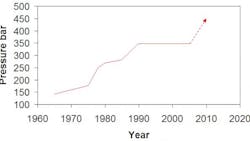In most hydraulic applications there are essentially two ways to get the required power output: high flow at (relatively) low pressure; and low flow at high pressure. This is because power is a product of flow and pressure; increase pressure and you can reduce flow proportionately but still get the same power output. For example, 100 liters/min at 200 bar equates to the same power output as 50 liters/min at 400 bar.
Higher pressures mean higher force and torque is available from smaller components. And because these components are smaller in displacement, higher speeds are possible from smaller flows. Smaller flows mean pipework, valving and even the tank can be made smaller - remember, the old rule of thumb for tank size (largely ignored these days) is 3 to 5 times pump flow/min.
So the power density of individual components and the system as a whole increases with pressure. But there are a number of disadvantages with higher operating pressures:
- The inherent heat dissipation of the system is lower because the surface area of the tank (it's smaller in volume), pipework and components are less. In other words, a bigger heat exchanger is required for a high-pressure system of the equivalent power and efficiency.
- Greater variation in fluid volume (compression) at higher pressures means reduced stiffness of the system and less favorable dynamic response.
- Higher noise levels as a result of higher peak pressures and greater energy transmission for a given mass.
- The potential for greater friction and wear, resulting from heavier loads on bearings and sliding surfaces, and more severe damage resulting from aeration, cavitation and micro-dieseling due to higher compression ratios.
In the majority of applications though, the advantages presented by higher operating pressures outweigh the disadvantages. Which is why for several decades now, we've seen the average operating pressures of hydraulic equipment increase. But clearly, it comes with some design problems. Here's a few that spring to mind:
- Heavier hose construction, i.e., less flexible lines, longer bend radii and possibly, special fittings and assembly methods.
- Heavier valve bodies, actuators, pumps, pipes -- or the use of more exotic, and expensive, materials in their construction.
- More advanced seal materials, new groove designs and closer tolerances will be required to ensure sealing integrity doesn't suffer.
- Greater attention to reservoir configuration, conductor selection and component locations to accommodate components resonating with more energy and emitting higher sound pressure levels.
Beyond these material-strength and noise issues, also consider for a moment how increasing operating pressures will impact reliability. We know that force in a hydraulic system is a product of pressure and area. So when operating pressure increases - so do loads on lubricated surfaces.
Oil viscosity and film strength are vital to maintain full-film lubrication between heavily loaded contacts. I already consider the oil to be THE most important component of any hydraulic system. But this will definitely be the case for machines operating at higher pressures. Oil selection AND maintenance will be critical for optimum reliability.
Similarly, contamination control will be more important than ever. Because the more heavily loaded the lubricated contacts - the more susceptible they are to wear and damage from water and particle contamination.
For machine designers, issues such as tank size, installed cooling capacity, filtration, contamination control, and oil recommendations will be even more important than they are now. And the impact of mistakes or omissions at the design stage on equipment reliability will be even more significant.
For hydraulic equipment users whose maintenance practices are unsophisticated or non-existent - their hydraulic equipment operating costs can only go up. Due to a likely higher incidence of premature failures resulting from temperature, oil degradation, lubrication and contamination issues. In other words, the absence of proactive maintenance will be more costly than ever. And to discover six other costly mistakes you want to be sure to avoid with your hydraulic equipment, get "Six Costly Mistakes Most Hydraulics Users Make... And How You Can Avoid Them!" available for FREE download here.
About the Author
Brendan Casey Blog
Author
Brendan Casey is a war-weary and battle-scarred veteran of the hydraulics industry. He's the author of The Hydraulic Troubleshooting Handbook, Insider Secrets to Hydraulics, Preventing Hydraulic Failures, The Definitive Guide to Hydraulic Troubleshooting, The Hydraulic Breakdown Prevention Blueprint and co-author of Hydraulics Made Easy and Advanced Hydraulic Control. And when he's not writing about hydraulics or teaching it, Brendan is flat-out helping consulting clients from a diverse range of industries solve their hydraulic problems. To contact him visit his company's Website:
www.HydraulicSupermarket.com

Leaders relevant to this article:
